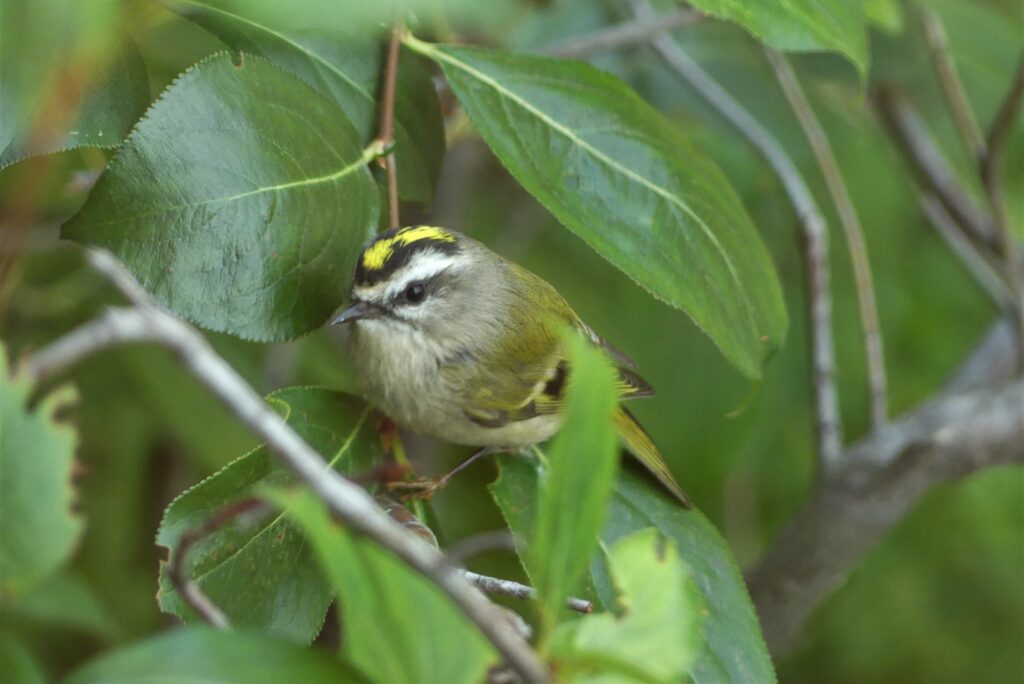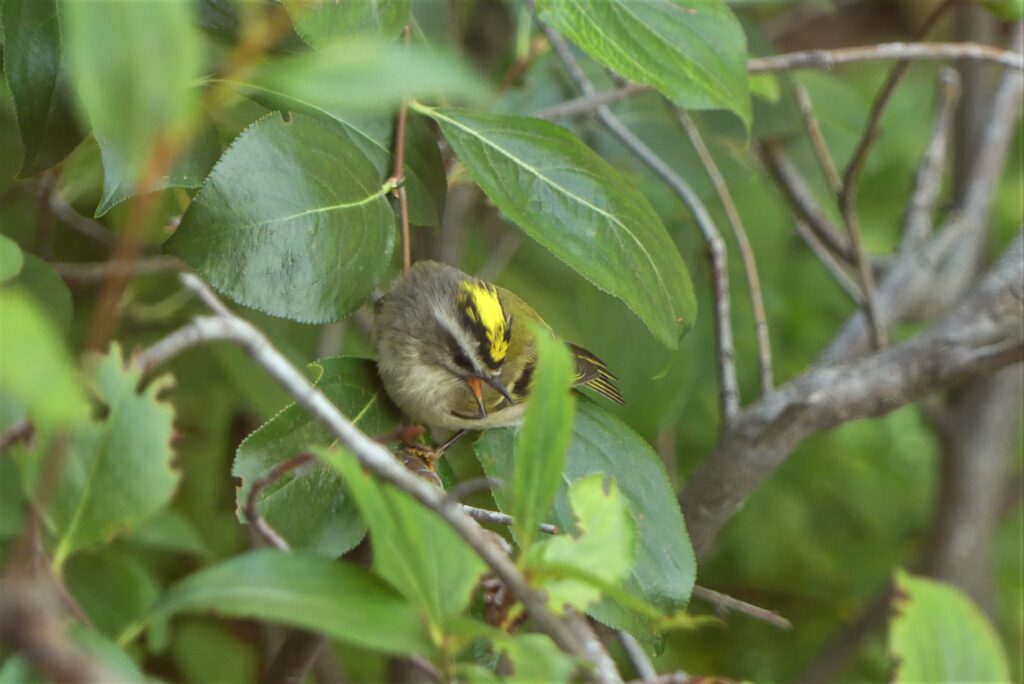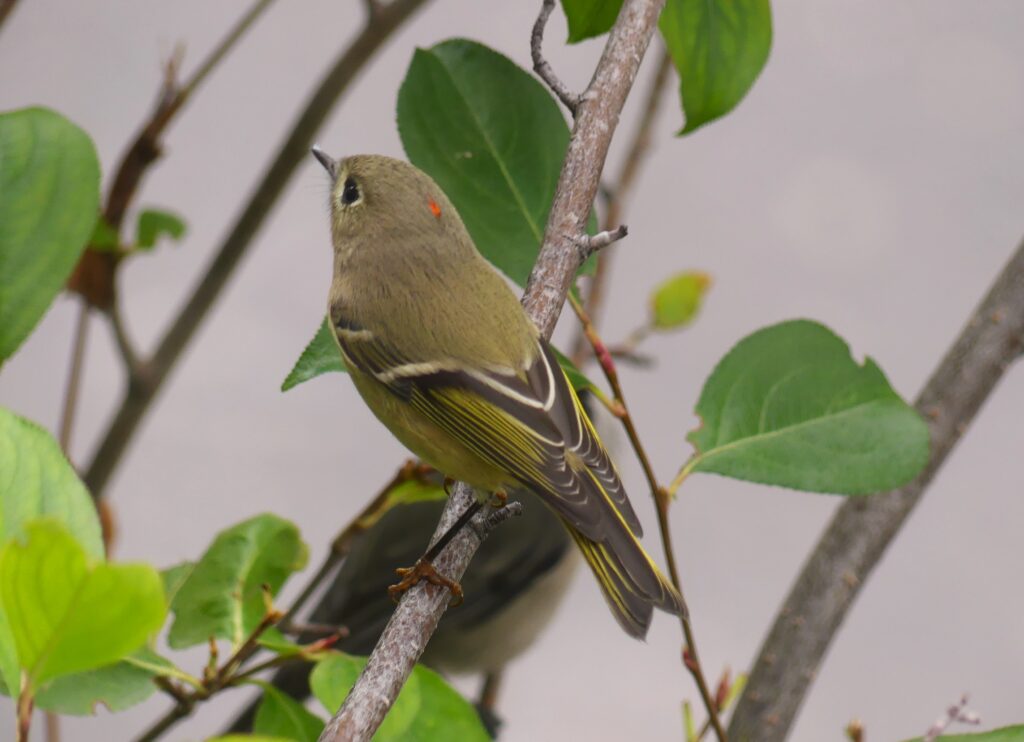by Pat Jaquith
pat@westvalleynaturalists.org

The Golden-crowned Kinglet is a permanent resident of conifer forests in our area. Regulus comes from Latin, meaning “little king”; satrapa is of Greek origin, meaning “ruler who wears a golden crown”. Males have a patch of orange feathers between the yellow, but they rarely display them. I’m assuming this one is a female, but it’s possible it’s a male in a peaceful mood!
At only a half-inch longer than our smallest bird, the Calliope Hummingbird, and weighing a mere .2 of an ounce, it’s no wonder we don’t see this little one very often. This high-energy little insectivore usually travels with others of its kind seeking food. They hover at the ends of twigs to gather microscopic mites, aphids, and aphid eggs; in summer their choice of insects is greater, and they occasionally find fruit to add to the protein sources. In winter, their most nourishing food is inchworms, the caterpillar of the geometrid moth, that they find frozen to twigs – mostly of conifers, but occasionally on maples, too.
The female Golden-crowned Kinglet constructs a hammock-like nest of moss, lichen, spider silk, rabbit hair, twigs, feathers, and other plant materials. Then she lays 8 to 11 bee-sized eggs in two layers, using her warm legs to incubate the lower layer! Usually, birds with a low success rate in raising young or migrating have big broods; Golden-crowned Kinglets’ survival challenge is overwintering in our cold climate on a low carbohydrate diet.


The Ruby-crowned Kinglet usually appears to have a plain gray head; the day I saw this one, it was involved in a furious game of chase with a number of other tiny birds, many of which were Kinglets. Both species of Kinglets were involved in this game in mid-September. The participants could have been members of just two families: parents and offspring. This “little king” was agitated enough that a tiny wisp of its ‘crown jewel’ showed!
Ruby-crowned Kinglets are a quarter of an inch longer and have a stockier physique than the Golden-crowned. Both of the Kinglets start out their families with around a dozen eggs; the Ruby-crowned Kinglets migrate a little south or toward the Pacific where the winters are less challenging, so it is felt that their losses are in migration, rather than in winter survival. Some ornithologists feel that there are enough differences between the two species that they should be in separate genera. Their voices are distinct: the Ruby-crowned calls with a volume that is much bigger than one would expect of such a little bird! The Golden-crowned has a quiet, very high pitched voice – one of the birds that people with hearing loss in the upper range will not hear at all.

These little birds seem to be in constant motion, flitting through branches, seeming to never sit still to give me a chance with the camera! The pronounced white eye ring, tiny bill, and the dark partial bar on its wing are key features I look for. The larch needles are a good measuring stick for comparing the diminutive size of the cute little whirlwind.
I rely chiefly on the book Winter World by Bernd Heinrich (2003) for researched data on Kinglets.

Very informative and interesting article. I wonder where they build their nests, in what part of the tree?
Thanks for your interest! I’ve seen evidence that the little birds were nesting nearby, but didn’t want to disturb them enough to locate the nest. However, according to Heinrich, they nest in thick branches of a conifer tree, underneath an overhanging bough that both provides shelter from weather and conceals its location. Apparently, when adults approach the nest, they land well above the nest and drop down through the branches to the nest, thus disguising their destination.